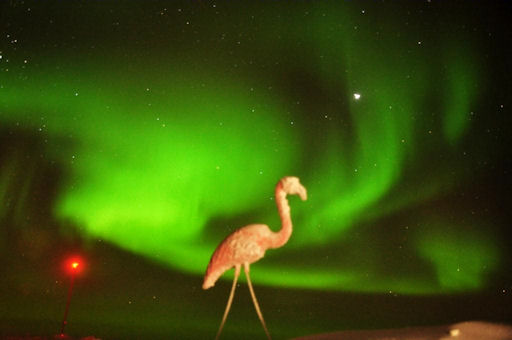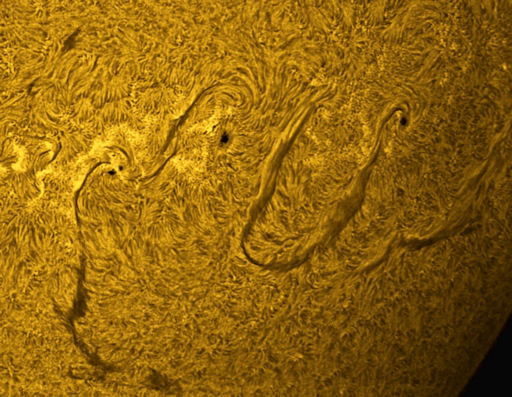Turn your cell phone into a field-tested satellite tracker. Works for Android and iPhone. | | |
GROUND CURRENTS IN NORWAY: A solar wind stream is buffeting Earth's magnetic field and this is causing electrical currents to flow in the earth itself at high latitudes. Rob Stammes sends this report from the Polarlightcenter in Lofoten, Norway: "Today, a magnetic disturbance began around 12.00 UTC. The [shaking of Earth's magnetic field] induced a ground current around our observatory: data. This is a good sign that we will see Northern Lights tonight." Aurora alerts: text, phone.
ODD JUXTAPOSITION: There's only one place in the world where Northern Lights routinely shine down on a pink flamingo: Summit Station, Greenland. Thomas Cox took this picture just after a CME impact ignited auroras over the NSF-sponsored climate research facility on Nov. 28th:

"The auroras were so vibrant and swirly, that I thought I was in a scene from Harry Potter!" says Cox.
Summit Station is located atop 3200 meters of ice and and is nearly 400 km from the nearest point of land. Scientists who "winter over" there keep a pink flamingo stuck in the ice to remind them of warmer places. The plastic creature frequently poses for aurora mugshots.
Auroras from the CME impact are subsiding, but another display is in the offing. Earth is entering a solar wind stream that could re-energize geomagnetic activity around the poles. High-latitude sky watchers should remain alert for auroras. Aurora alerts: text, phone.
more images: from DMSP satellites in Earth orbit; from Jónína Óskarsdóttir of Faskrudsfjordur, Iceland; from Paul Beebe of Lang Lake, Upsala, Ontario, Canada; from Jochen Hagemann of Reykjavik, Iceland; from Fredrik Broms of Kvaløya, Norway; from Antti Pietikäinen of Muonio, Lapland, Finland; from Zoltan Kenwell of Alberta, Canada; from Dirk S.Miller of Rice Lake, Wisconsin; from Warren Gammel of Big Lake, Minnesota; from Ulf Jonsson of Gussö, Luleå, Sweden; from Helge Mortensen of Kvaløya, Norway; from Hanneke Luijting of Tromsø, Norway;
SINUOUS SUNSPOTS: A line of sunspots stretching across the sun's northern hemisphere appears to be an independent sequence of dark cores. A telescope tuned to the red glow of solar hydrogen, however, reveals something different. The sunspots are connected by sinuous filaments of magnetism:

"These sunspots writhe and squirm energetically as they rotate away from us!" says John Nassr, who took the picture on Nov. 28th from his backyard observatory in Baguio, the Philippines.
The connections suggest an interesting possibility. While each sunspot individually poses little threat for strong solar flares, an instability in one could start a chain reaction involving all, leading to a widespread eruption. Readers with solar telescopes are encouraged to monitor developments.
more images: from Leonard E. Mercer of Attard, Malta; from Ron Cottrell of Oro Valley, Arizona; from Jo Dahlmans of Ulestraten, The Netherlands; from Peter Desypris of Athens,Greece

